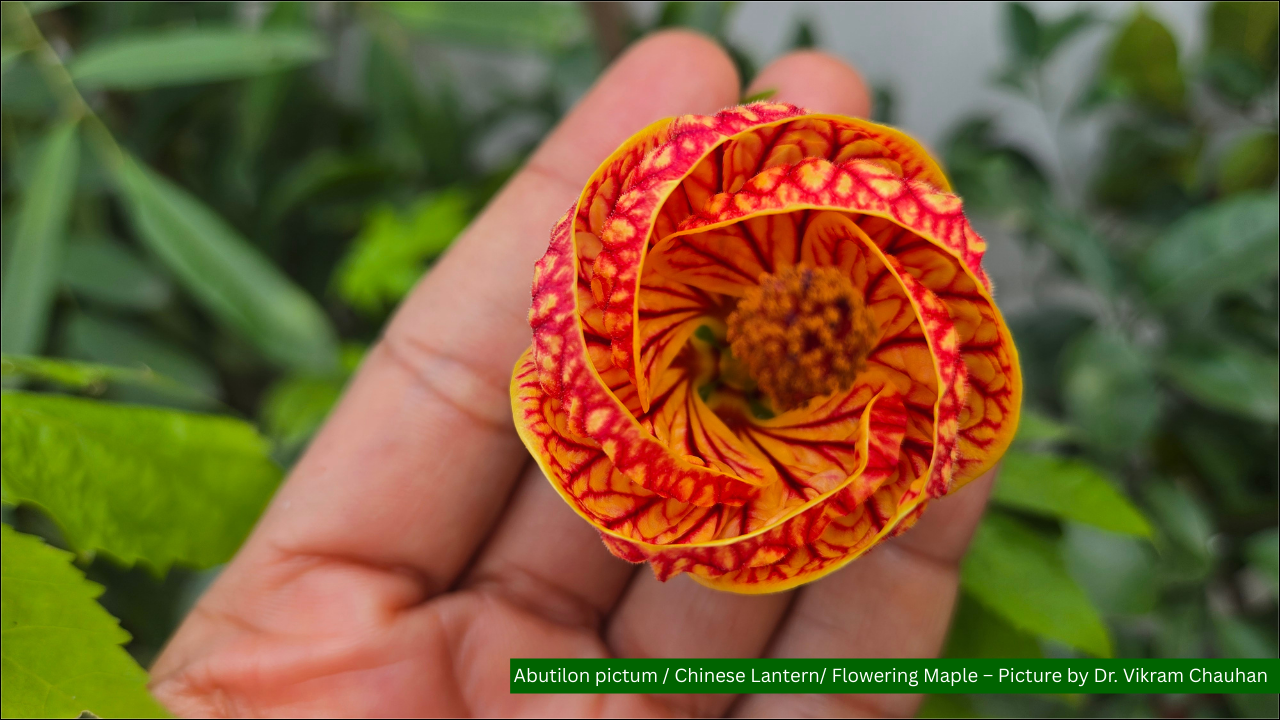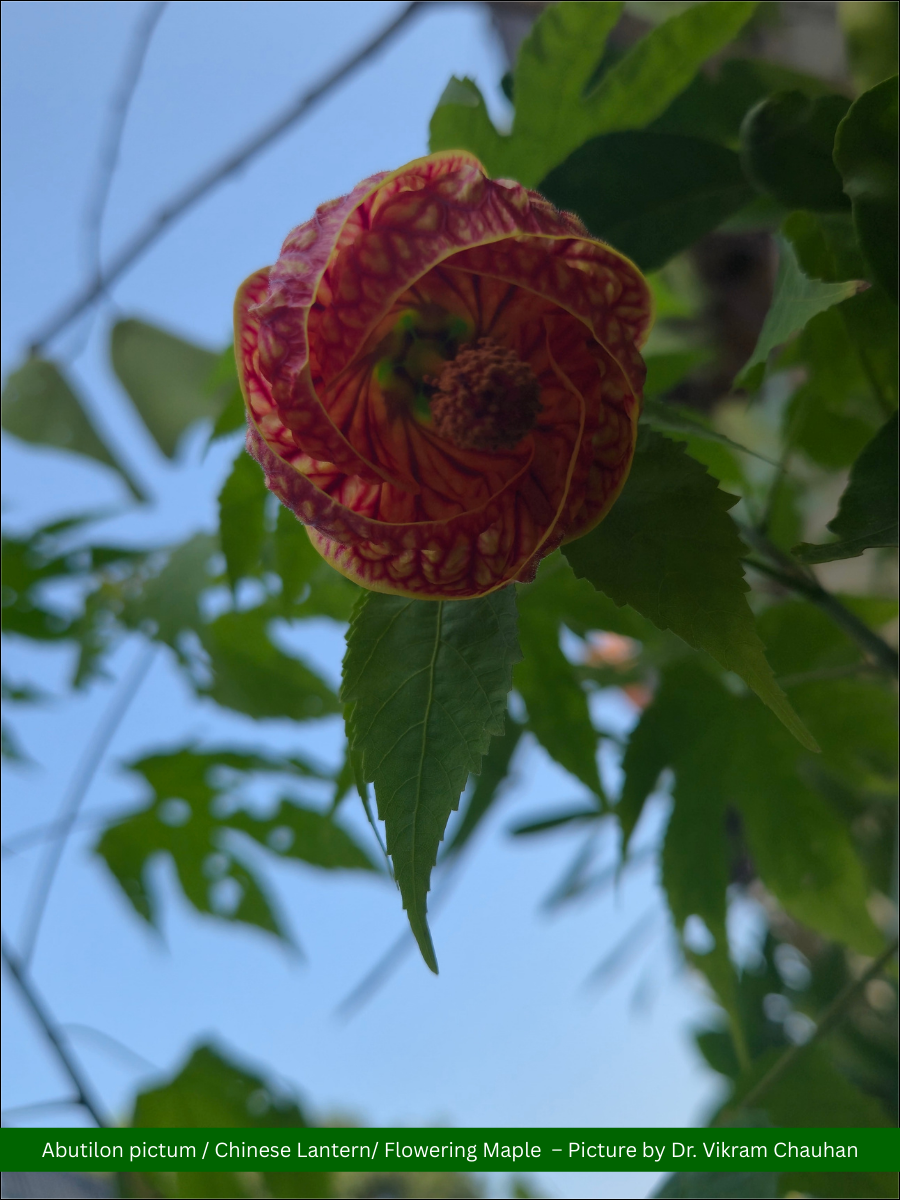Abutilon pictum / Chinese Lantern/ Flowering Maple – Ayurvedic Uses, Benefits, Dosage & Therapeutic Actions
Abstract
Abutilon pictum is an evergreen shrub of the Malvaceae family, appreciated worldwide as an ornamental for its bell-shaped, veined flowers and lobed maple-like leaves. It is native to southern South America, and it has been widely cultivated and naturalised in subtropical and warm-temperate regions. It is commonly called red-vein abutilon or painted mallow, and eaten locally in small amounts (flowers). It is primarily used in horticulture. The most distinctive feature of this plant is its striking flowers. They are bell-shaped, ranging in colour from yellow to red-orange, and beautifully adorned with dark red veins. This species is aptly known as the Redvein Abutilon because it belongs to the Abutilon genus.

Introduction
Abutilon pictum is a plant commonly associated with hibiscus because it belongs to the same botanical family, Malvaceae, giving it similar floral traits and appearance. Abutilon pictum (sometimes treated as Abutilon striatum) is grown for its prolific display of showy, veined, pendulous flowers and attractive foliage. Gardeners prize it for container culture, patios and subtropical borders where it blooms for long seasons, and pollinators such as bees and hummingbirds are attracted to the flowers. It belongs to the mallow family (Malvaceae) and shows the characteristic mucilaginous tissues of that family. The flowers of the Redvein Abutilon are edible and can be enjoyed either raw or cooked. They possess a pleasantly sweet flavour and remain open throughout their growth period. During this time, the flowers continuously produce nectar, which makes them progressively sweeter the longer they stay open. Their sweetness is most pronounced when grown indoors, where pollinators do not consume the nectar.
Scientific Classification
- Kingdom: Plantae
- Phylum: Tracheophyta
- Class: Magnoliopsida
- Order: Malvales
- Family: Malvaceae
- Genus: Abutilon
- Species: Abutilon pictum
Scientific Synonyms
- Callianthe picta
- Abutilon striatum (disputed)
- Sida picta



Vernacular Names
- English: Chinese Lantern, Redvein Abutilon, Red Vein Indian Mallow, Flowering Maple (named for its maple-like leaves, though not a true maple), Painted Indian Mallow, Redvein Flowering Maple, Parlour Maple.
- Chinese: Golden Bell Flower (金钟花 – Jīn zhōng huā), named for its bell-shaped, golden-yellow blossoms.
Habitat
Abutilon pictum is native to southern Brazil, Paraguay, Uruguay and adjacent parts of Argentina, and it has become naturalised elsewhere in warm regions. It prefers warm, frost-free climates and thrives in well-drained, fertile soils with consistent moisture. In cultivation, it tolerates light shade to full sun and is commonly grown in gardens, containers, patios and as a greenhouse or conservatory plant in cooler climates. Because of its South American origin, it is adapted to subtropical to warm-temperate conditions and may be tender where temperatures fall below freezing.
The Redvein Abutilon thrives in full sun and warm temperatures ranging between 20–38°C, preferring well-drained garden soil with moderate moisture. It should be watered every 1–2 weeks, keeping the soil evenly moist but not waterlogged. A balanced, water-soluble fertiliser applied monthly during spring and summer, and less frequently in cooler months, supports healthy growth and flowering. Its pruning in late spring encourages bushier growth and abundant blooms, while propagation through cuttings during spring or summer ensures successful reproduction. Repotting every 2–3 years with fresh soil and a slightly larger pot maintains plant vigour and continuous flowering.
Morphology
Abutilon pictum is an evergreen shrub that can reach up to about 3–5 m tall in favourable conditions, though many garden cultivars are kept smaller by pruning. Leaves are alternate, simple and palmately lobed (typically three to five lobes), often 5–15 cm long, with a soft, slightly hairy (pubescent) surface typical of many mallows. Flowers are pendulous, bell-shaped (campanulate), 2–4 cm long with five petals, and their colours range from yellow through orange to deep orange/red with conspicuous dark red veins (hence the common name red-vein). Fruit is a schizocarp (typical mallow fruit) that splits into several one-seeded segments. The plant has mucilaginous tissues and can produce a profuse floral display over an extended season under warm conditions.
Therapeutic Properties
- Anti-inflammatory
- Antimicrobial
- Blood circulation boosting
- Hepatoprotective
- Antioxidant
Chemical Composition
1. Whole Plant
- Contains mucilaginous substances and asparagine.
- Main compounds: Saponins, flavonoids, alkaloids, hexoses, and n-alkanes.
- Specific examples: β-sitosterol, vanillic acid, p-coumaric acid, caffeic acid, and fumaric acid.
- Amino acids: Galacturonic acid, p-β-D-glycosyloxybenzoic acid, and various other amino acids.
2. Essential Oils
- Main components: α-pinene, β-caryophyllene oxide, eudesmol, farnesol, borneol, geraniol, and α-cineole.
- Minor components: Element, geranyl acetate, and other minor volatile constituents.
3. Seeds
- Rich in fatty acids such as cis-12,13-epoxyoleic (vernolic) acid, 8,9-methylene-heptadec-8-enoic (malvalic) acid, palmitic acid, stearic acid, oleic acid, and linolenic acid.
4. Aerial Parts
- Sterols: β-sitosterol.
- Flavonoids: Gossypetin-8-glucoside, Gossypetin-7-glucoside, and cyanidin-3-rutinoside.
- Other compounds: Tocopherols (Vitamin E compounds).
5. Roots
- Contains gallic acid, known for its antioxidant and antimicrobial properties.
Practical Uses
- Add 4-5 fresh flowers or 1 tablespoon of dried flower petals of Abutilon pictum and boil them in 250 ml of water. Simmer for 5–7 minutes and let it steep for another 5 minutes, then strain and use it as tea. This tea is mainly used in Europe.
- For Cough and Cold: A decoction made from the leaves and flowers helps relieve sore throat, cough, and mild respiratory infections due to its demulcent and soothing properties.
- For Wound Healing: The leaf paste can be applied externally on minor wounds, burns, and insect bites to promote healing and reduce inflammation.
- For Fever: A tea made from the flowers acts as a mild febrifuge, helping to reduce body temperature and promote relaxation.
- For Constipation: The mucilaginous content of the leaves and flowers provides a gentle laxative effect, aiding bowel movement.
- For Skin Care: Flower or leaf extracts are used to soothe skin irritation, dryness, and rashes owing to their anti-inflammatory nature.
- For Urinary Problems: A mild decoction of the roots is used in traditional medicine to alleviate urinary burning and promote kidney health.
Part Used
- Root
- Bark
- Leaves
- Flowers
- Seeds
Conclusion
Abutilon pictum, commonly known as Redvein Abutilon or Flowering Maple, is an attractive ornamental shrub valued for its vibrant bell-shaped flowers and ease of cultivation. The plant holds notable medicinal potential due to its rich content of flavonoids, alkaloids, saponins, and essential oils, beyond its aesthetic appeal. Its various parts exhibit anti-inflammatory, antimicrobial, and antioxidant properties, making it beneficial for minor ailments such as cough, wounds, and skin irritations. Additionally, its edible flowers and soothing herbal tea add nutritional and therapeutic value. Overall, Abutilon pictum represents a versatile plant with both horticultural charm and pharmacological significance.
Frequently Asked Questions (FAQ’s)
1. What Are The Uses Of Abutilon Pictum?
Answer- It is mainly grown as an ornamental shrub for its attractive, veined bell-shaped flowers and foliage, enhancing gardens and attracting pollinators.
2. What Are The Medicinal Uses Of Abutilon Pictum?
Answer- Abutilon species show anti-inflammatory, antioxidant, and wound-healing properties.
3. What Are The Common Names Of Abutilon Pictum?
Answer- It is known as Red-vein Abutilon, Painted Mallow, Flowering Maple, and Chinese Lantern; often confused with Abutilon indicum (Atibala) in India.



